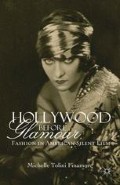Abstract
In 1914, a young Gloria Swanson dressed up in her most fashionable ensemble to visit Essanay studios in Chicago. In her autobiography, Swanson recalled it was “one of the new Staten Island outfits [she] was dying to wear. It was a black-and-white checkered skirt with a slit in the front from an Irene Castle pattern and a black cutaway jacket with a green waistcoat. I wore a perky little Knox felt hat with it.”1 Her memory of this day was probably sparked by the photograph of the graphic ensemble that is tipped into one of the innumerable scrapbooks documenting her career (Figure 1.1). Swanson wrote in cursive above the picture: “Simple Sixteen and oh so chic.” Although she did not go to the studios to look for work, the casting director asked her to return the next day to play a role in a moving picture. Swanson told her aunt that she was certain her suit’s provenance – modeled after the clothing of famed dancer and fashion icon Irene Castle – was the real reason for his interest. The next day the casting director telephoned and requested that she wear the same outfit, proving her right.2
Access this chapter
Tax calculation will be finalised at checkout
Purchases are for personal use only
Preview
Unable to display preview. Download preview PDF.
Notes
Gloria Swanson, Swanson on Swanson (New York: Random House, 1980), 25, 27.
Eileen Bowser defines the nickelodeon period as lasting from 1907 to 1915. See Eileen Bowser, The Transformation of Cinema, 1907–1915 (Berkeley and Los Angeles: University of California Press, 1990), 1, 121.
Caroline Rennolds Milbank argues that French couture became more influential in the post-World War I era; see New York Fashion: The Evolution of American Style (New York: Harry Abrams, 1989), 72. See also Kristen Thompson, Exporting Entertainment: America in the World Film Market, 1907–1934 (London: British Film Institute, 1985).
Bowser cites a June 1910 New York Dramatic Mirror article as the first known use of the term “motion picture star.” See Bowser, The Transformation of Cinema, 113. See also Richard deCordova, “The Emergence of the Star System in America,” in Christine Gledhill, ed., Stardom: Industry of Desire (New York: Routledge, 1991), 17.
Elizabeth Wilson, Adorned in Dreams: Fashion and Modernity (Berkeley: University of California Press, 1987).
Walter Benjamin, “The Work of Art in the Age of Mechanical Reproduction” (originally published 1936), reprinted in Hannah Arendt, ed., Harry Zohn, transl., Illuminations: Essays and Reflections (New York: Schocken Books, 1968); Walter Benjamin, Arcades Project, Howard Eiland and Kevin McLaughlin, transl. (Cambridge, MA: Belknap Press of Harvard University, 1999); I have also drawn on Susan Buck-Morss’s overview of Benjamin, The Dialectics of Seeing: Walter Benjamin and the Arcades Project (Cambridge, MA: MIT Press, 1999).
Jane Gaines, “Costume and Narrative: How Dress Tells the Woman’s Story,” in Gaines, ed., Fabrications: Costume and the Female Body (New York: Routledge, 1990), 186.
Rebecca Arnold, Fashion, Desire and Anxiety: Image and Morality in the 20th Century (New Brunswick, NJ: Rutgers University Press, 2001).
Charles Musser, “At the Beginning: Motion Picture Productions, Representation, and Ideology at the Edison and Lumière Companies,” in Lee Grieveson and Peter Krämer, eds., The Silent Cinema Reader (London: Routledge, 2004), 15–16.
Advertising World 16 (March 1912), 11, cited in William R. Leach, “Transformations in a Culture of Consumption: Women and Department Stores, 1890–1925,” Journal of American History vol. 71, no. 2 (Sep. 1984), 327.
Miriam Hansen, Babel and Babylon: Spectatorship in American Silent Films (Cambridge, MA: Harvard University Press, 1991).
Copyright information
© 2013 Michelle Tolini Finamore
About this chapter
Cite this chapter
Finamore, M.T. (2013). Introduction. In: Hollywood Before Glamour. Palgrave Macmillan, London. https://doi.org/10.1057/9780230389496_1
Download citation
DOI: https://doi.org/10.1057/9780230389496_1
Publisher Name: Palgrave Macmillan, London
Print ISBN: 978-1-349-35117-6
Online ISBN: 978-0-230-38949-6
eBook Packages: Palgrave Media & Culture CollectionLiterature, Cultural and Media Studies (R0)

